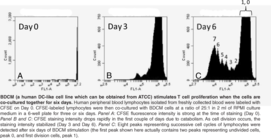服务热线
021-60498804
产品中心
/ Products Classification 点击展开+
| Cat. Number | 066209622725824 |
||||||||||||||
| Chemical Name | CFSE Cell Division Assay Kit |
||||||||||||||
| References |
Background ReadingParish, C.R., Glidden, M.H., Quah, B.J.C., et al. Use of the intracellular fluorescent dye CFSE to monitor lymphocyte migration and proliferation. Curr Protoc Immunol 4.9.1-4.9.13 (2009). ulic, S., Panic, L., Ðikic, I., et al. Deregulation of cell growth and malignant transformation. Croat Med J 46(4) 622-638 (2005). Lyons, A.B. Analysing cell division in vivo and in vitro using flow cytometric measurement of CFSE dye dilution. J Immunol Methods 243 147-154 (2000).
Description
Cell proliferation is controlled by growth factors that bind to receptors on the cell surface, which in turn connect to signaling molecules. These molecules activate transcription factors which bind to DNA to turn on or off the production of proteins which result in cell division. Dysfunction of any step in this regulatory cascade causes abnormal cell proliferation, which underlies many human pathological conditions.1 The mechanisms underlying alterations in cell cycle progression are crucial to understanding many human diseases, most notably cancer. Carboxyfluorescein diacetate, succinimidyl ester (CFDA-
1 ulic, S., Panic, L., Ðikic, I., et al. Deregulation of cell growth and malignant transformation. Croat Med J 46(4) 622-638 (2005). 2 Parish, C.R., Glidden, M.H., Quah, B.J.C., et al. Use of the intracellular fluorescent dye CFSE to monitor lymphocyte migration and proliferation. Curr Protoc Immunol 4.9.1-4.9.13 (2009). 3 Lyons, A.B. Analysing cell division in vivo and in vitro using flow cytometric measurement of CFSE dye dilution. J Immunol Methods 243 147-154 (2000). |
||||||||||||||





